Why Iceland banned beer
- Published
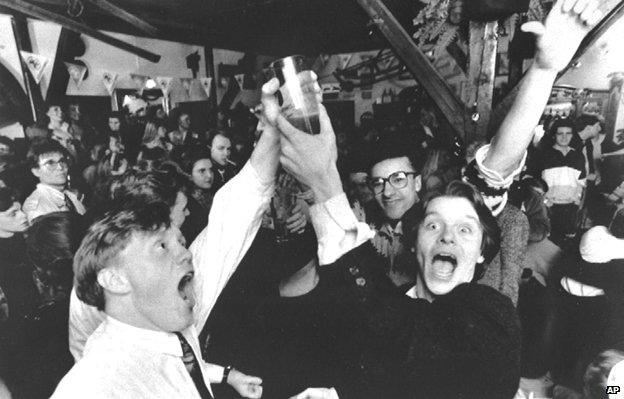
A century ago, Iceland banned all alcoholic drinks. Within a decade, red wine had been legalised, followed by spirits in the 1930s. But full-strength beer remained off-limits until 1 March 1989. Megan Lane asks why it took so long for the amber nectar to come in from the Icelandic cold.
When the mercury hovers below zero, a cold beer is not the first drink that springs to mind. A warming shot of schnapps might be more appropriate.
But on 1 March 1989 - when the top temperature in Iceland was -5C (23F) - beer was exactly what drinkers had in mind. It was the first time in 74 years they'd had a chance to legally order beer. And order it they did, in rowdy scenes televised live on national television.
Historian Unnar Ingvarsson was 21 at the time and living in a small town. "It was a big party. I and my friends bought a case each... We managed to finish them quickly and went to the pub where we stayed and drank through the night.
"A girl who had been living in Australia taught us drinking games - we lost obviously."
This red-letter day is marked annually as Bjordagur (Beer Day), though it tends to be much quieter now than the bacchanalian scenes witnessed 26 years ago.
A generation on, beer accounts for 62% of the 7.1 litres of pure alcohol consumed each year by the average Icelander. That's higher than in traditional brewing countries such as Germany and the Czech Republic (54% each) and the UK (37%), according to the most recent World Health Organization figures, external.
But for much of the 20th Century it was unpatriotic - and illegal - to drink beer.
When full prohibition became law 100 years ago, alcohol in general was frowned upon, and beer was especially out of favour - for political reasons. Iceland was engaged in a struggle for independence from Denmark at the time, and Icelanders strongly associated beer with Danish lifestyles.
"The Danes were drinking eight times as much alcohol per person on a yearly basis at the time," says historian Stefan Palsson, author of Beer: Around the World in 120 Pints.
As a result, beer was "not the patriotic drink of choice".
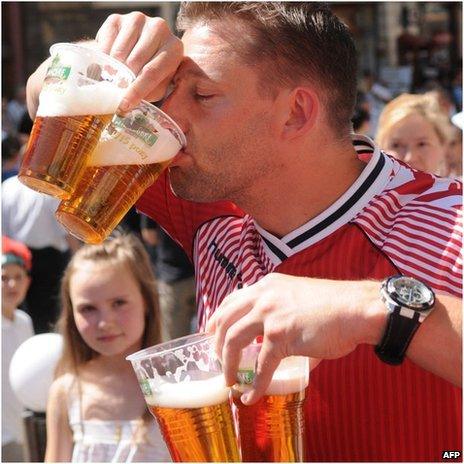
A Danish fan prepares for Denmark's Euro 2012 clash with Germany in Ukraine
The independence and temperance movements reinforced each other, and in 1908, four years after gaining home rule, Iceland held a referendum on a proposal to outlaw all alcohol from 1915. About 60% voted in favour. Women, who still didn't have the vote, were vocal in their support.
"Prohibition was seen as progressive, like smoking [bans] today," says Palsson.
It didn't take long for Prohibition to be undermined. Smuggling, home-brew and ambassadors lobbying for alcohol to oil the wheels of diplomacy all played a part.
"Doctors started prescribed alcohol as medicine and they did so in huge quantities, for more or less everything. Wine if you had bad nerves, and for the heart, cognac," says Palsson.
But beer was never "what the doctor ordered", despite the argument some put forward that it was a good treatment for malnourishment. "The head doctor put his foot down and said beer did not qualify as a medicine under any circumstances," Palsson says.
There were other leaks in the Prohibition armour too.
"Prohibition supporters complained that painters who never used to use spirits to clean their brushes were now getting litres and litres each year," says Palsson. "So alcohol was flowing in from all directions."
Then the Spanish threatened to stop importing salted cod - Iceland's most profitable export at the time - if Iceland did not buy its wine. Politicians bowed to the pressure and legalised red and rose wines from Spain and Portugal in 1921.
Over time, support for prohibition dwindled. It had already been repealed by all the other European nations that had experimented with it (apart from the Faroe Islands) when in 1933 Icelanders voted to reverse course.
But even then the ban remained in force for beer containing more than 2.25% alcohol (about half the strength of an average-strength beer). As beer was cheaper than wines or spirits, the fear was that legalising it would lead to a big rise in alcohol abuse.
The association of beer with Denmark also continued to tarnish its image in a country that only achieved full independence in 1944.
However, beer remained accessible, just about, to those who really wanted it. "If you knew a fisherman, he may have had a few cases stashed in his garage - usually the cheapest and strongest beer available, often stored too long," says Palsson
Also popular, according to Ingvarsson, was tipping brennivin (burning wine), a potato-based vodka, into non-alcoholic beer - which tasted, as he puts it, "interesting and totally disgusting".

Some Icelandic drinks
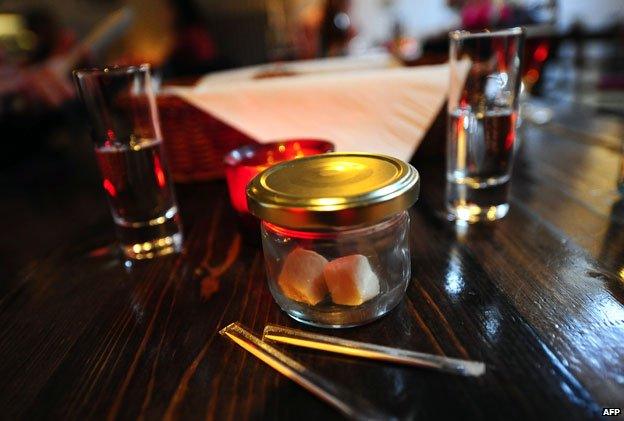
Glasses of brennivin, and a jar containing hakarl (decomposed shark flesh)
Brennivin - a clear schnapps, made from fermented grain or potato mash and flavoured with caraway; also known as Black Death, which one Icelandic blogger, external says "explains a lot". She continues: "Many Icelanders never touch it, and a majority of the ones who drink it only do so when feeling patriotic, such as... when trying to impress foreign visitors."
Whale beer - the Icelandic micro-brewery Stedji has produced a number of ales flavoured with different parts of whale, including Hvalur 2, a brew infused with dried whale testicles, external; Stedji's beer has proved popular in Iceland, although the company has been criticised by conservationists

It wasn't until the 1970s with the rise of city break holidays, that attitudes really began to shift, Palsson suggests.
"You'd go to London to shop, to watch football and go to the British pubs, and this started to seem like something you would like to have over here," he says.
Another crack in the edifice of prohibition came in 1979, when businessman David Scheving Thorsteinsson challenged the rule that only pilots, cabin crew and foreign tourists could bring in duty-free beer. When his six bottles were confiscated, he refused to pay the fine. His cause was taken up by the MP Sighvatur Bjorgvinsson, whose bill to allow Icelanders the same rights was passed in 1980.
It became practically a civic duty for Icelanders to buy a duty-free crate at the airport: six litres of imported beer or eight litres of local beer (brewed in Iceland even though it was not legally available outside the airport). If they didn't like beer themselves, they'd pass it on to family, friends or colleagues.
Polls throughout the 1980s showed about six in 10 Icelanders supported legalising beer. "Beer is being consumed in Iceland," said Jon Magnusson of the Independence Party in 1987. "Why should the state not get its piece of the cake in the form of taxes and so on?"
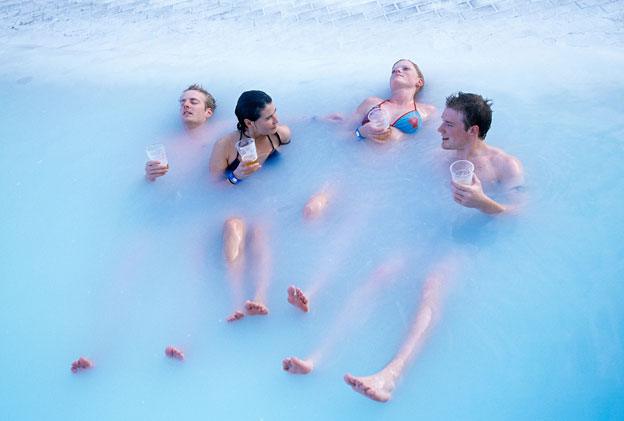
A cooling summer beer in the blue lagoon
Finally, in 1988, Iceland's parliament, the Althing voted to legalise beer, after debates that were televised live and attracted huge audiences. A dozen beer-lovers remained outside the building to flash victory signs following the conclusive post-midnight vote in the upper house, reported AP.
Today Icelanders drink less than many of their European counterparts. The 7.1 litres of pure alcohol drunk annually by over-15s in Iceland, on average, compares with 11.4 litres in Denmark, 11.6 in the UK, 12.2 in France and 15.1 in Russia, according to the World Health Organization's Global Status Report on Alcohol and Health 2014, external.
Iceland also has a relatively high proportion of abstainers, according to the WHO report - lifetime abstinence for 14.1% of the drinking age population, and 32.1% in the past 12 months. In Denmark, these figures are 4.5% and 11.4%, with 15.1% and 16.1% in the UK.
But when it comes to binge drinking, Iceland's stats are on a par with the UK, and Palsson puts this down to drinking habits laid down in the beer prohibition years.
"Before 1989, most alcoholic consumption would take place over a few hours at weekends. So you needed big clubs which could serve a lot of customers in a short period of time. Some served bjorliki, pseudo-beer, a mixture of low-alcohol lager and different types of spirits served in large beer glasses."
Beer Day is not generally used as an excuse for binge drinking these days, however. Though it's mentioned in all the guidebooks, it isn't the festive blowout tourists often seem to expect, judging from surprised posts on TripAdvisor.
"Maybe we should make it into more of a celebration," says Audur Osp, who runs the popular I Heart Reykjavik, external travel blog. "I will go out for a beer myself to celebrate, possibly to one of the craft beer bars to try something new."
Ordering an Icelandic beer isn't always easy, unless you happen to speak the language. Some, such as Borg Snorri Nr. 10 and Ulfur Ulfur Double IPA Nr. 17, are just about pronounceable, but others - Olvisholt Suttungasumbl, for example, or Víking Islenskur Urvals Einiberjabock - are more of a challenge.
Once you have the glass in your hand, though, it's easy. You just say "Skal!" and drink.

The Magazine in Iceland
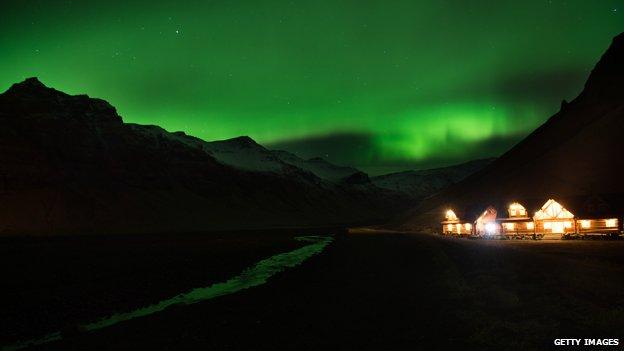

Subscribe to the BBC News Magazine's email newsletter to get articles sent to your inbox.